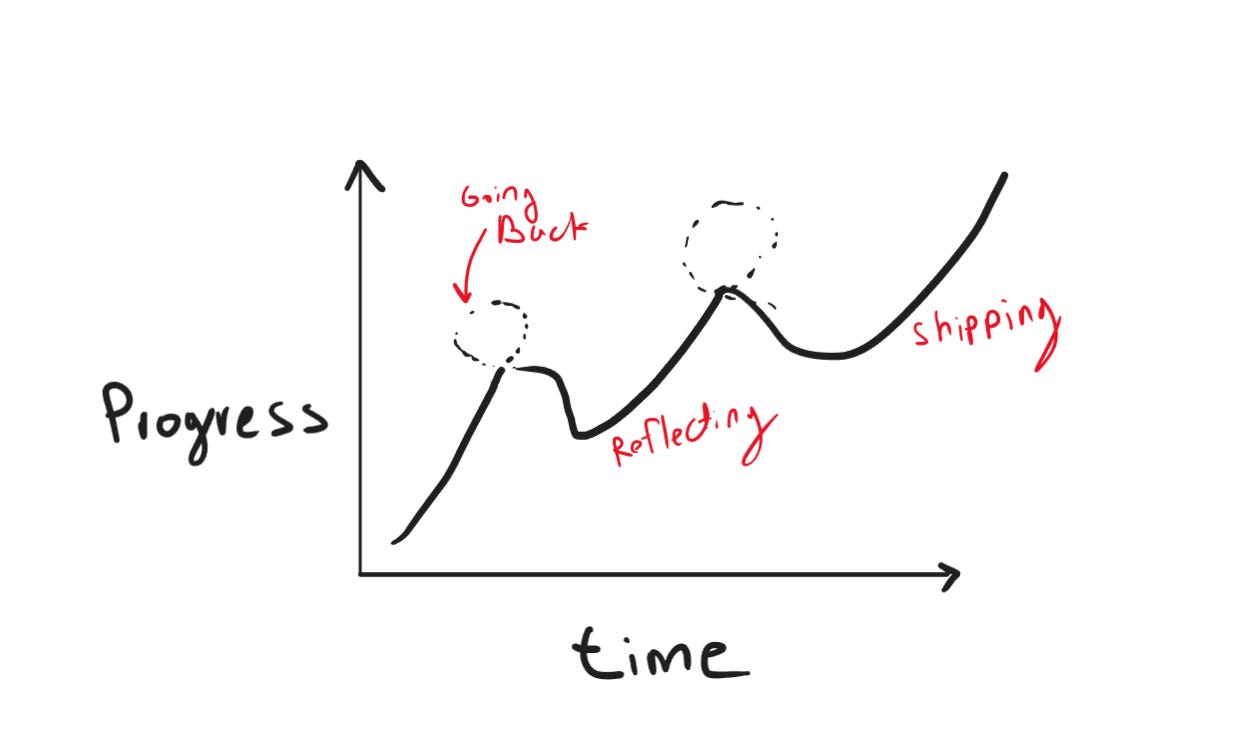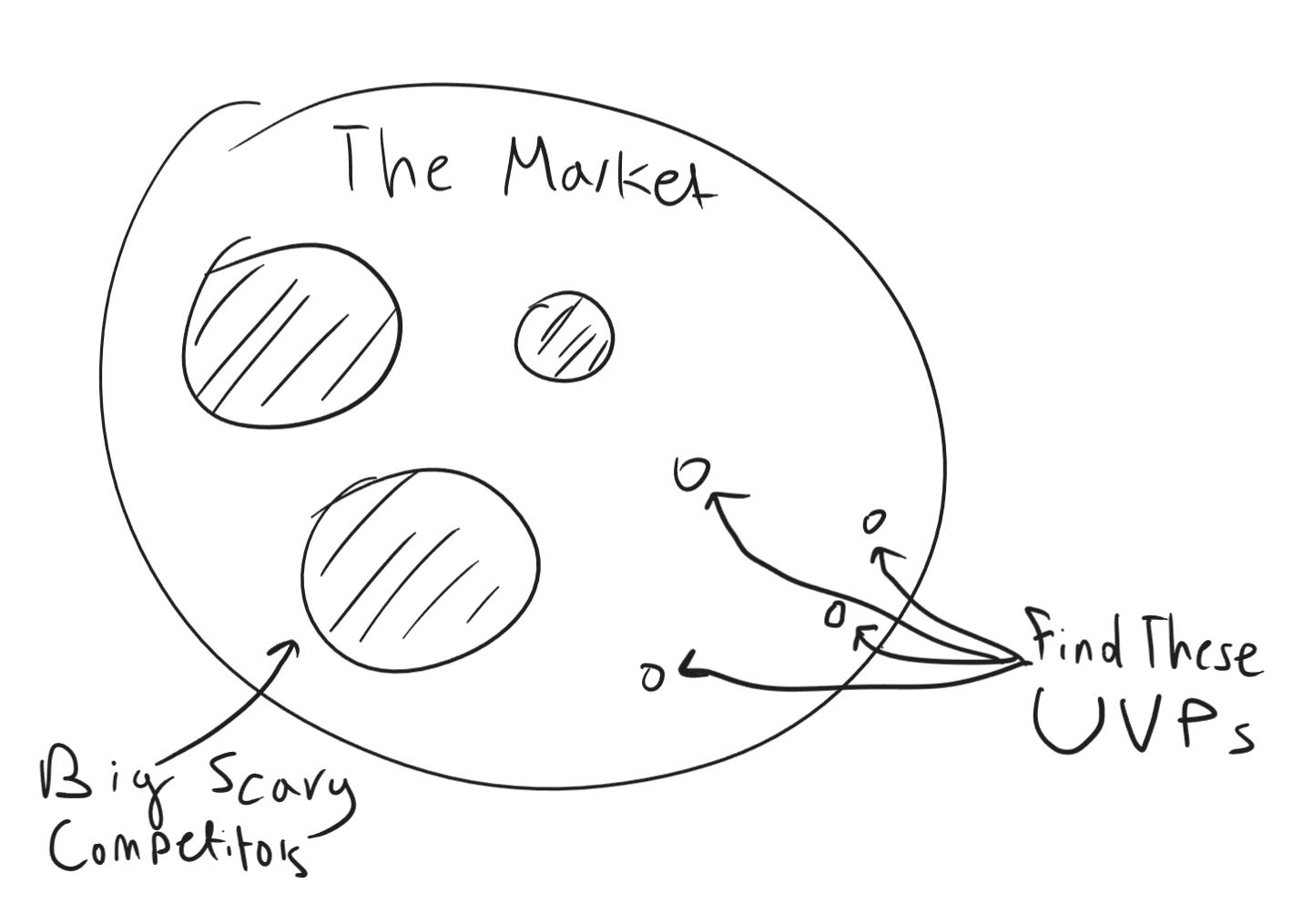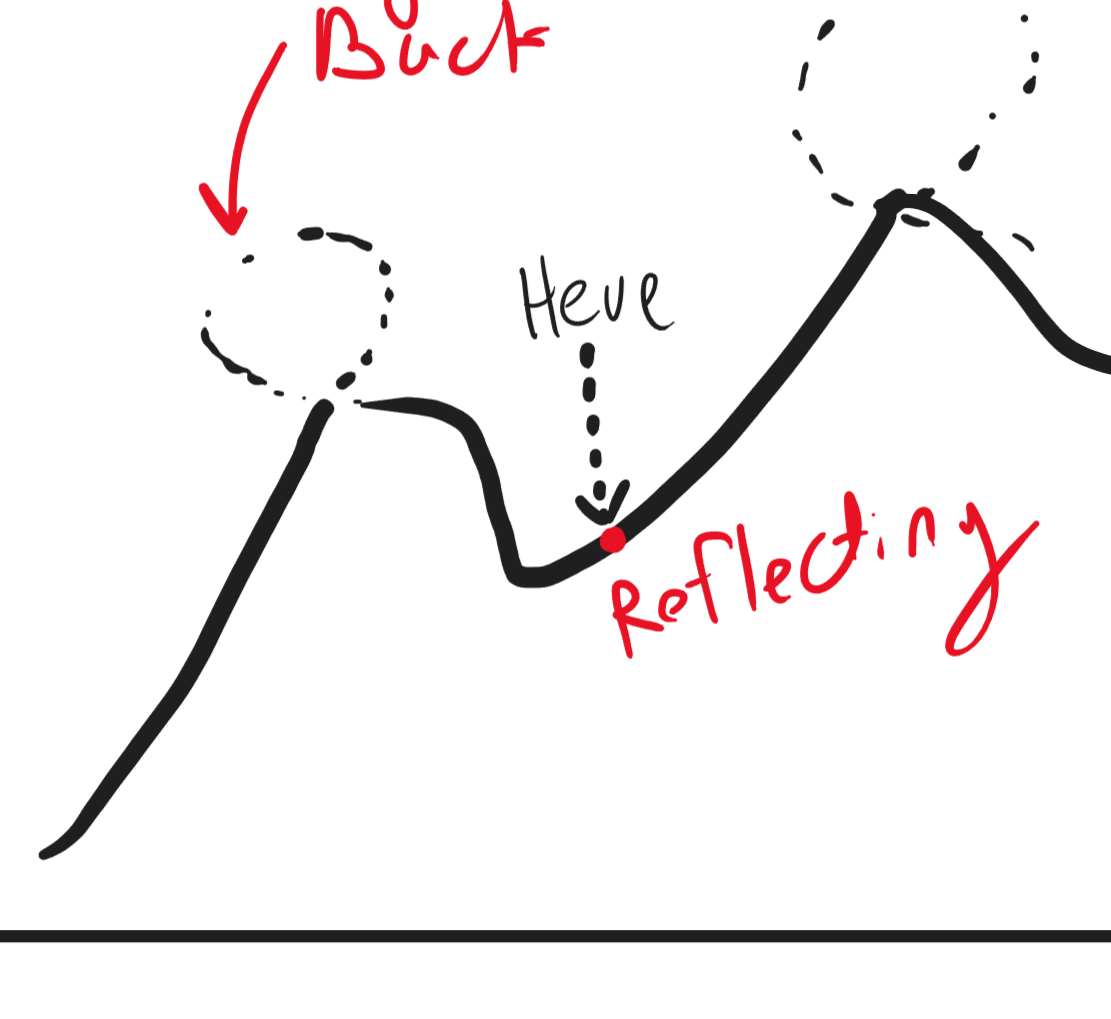I have properly started indie-hacking with Shannon and Zane from around December 22. The first project was another social network (I should’ve been a lawyer based on how much BS I advocated to justify that it was solving a problem). I was convinced then that my path was going to be filled with dozens of failed social apps (around 14 based on Nikita Biers's number). Sukhans told me that at some point I will want to make money and that B2B is a better way. He was right.
Side note: Grammarly is just killing my unique writing style with all these yellow highlights.
The main things I’ve learned are the importance of UVPs, what it actually means to solve a problem, and why it’s crucial to have a niche. I think every amateur founder/hustler has a bad outlook on the competition. For me, it was the “10x”.
The Market & Competitor Outlook
In startups, there is a lot of drilling that whatever you do has to be at least 10 times better than the alternative (competitor). Well, as a university student with 0 unique business insights, that’s pretty damn hard to do. So anytime I saw a competition, I thought, can I be 10 times better? Usually after admitting no, I would move on to another side project. We moved away from Podpigeon even though that was actually validated and even made a sale (sort of). However, I saw a bunch of products that do pretty much the same thing and we moved on. Later another completely new product called Podsqueeze was making 8k MRR on that exact same concept. That was definitely a kick in the balls and at times felt like we were in a better headspace months ago.
However, back then there was no solid understanding of how the market works.
Tally.so is one of the best success stories from indiehackers. Who are their competitors? Typeform, google forms, SurveyMonkey, and probably another fifty online survey form builders. Why are they successful? Well, when I and Shannon were making Fistbump surveys, even we spotted how bad the UX was. It felt clunky, slow, expensive and it was just not quite right. Tally perfectly conveyed that through their product and we completely skipped over this idea because we couldn’t make anything 10 times better than Typeform - and we were right. Tally is not ten times better than Typeform or Google Forms. In fact, they have downsides when comparing these two. So how are they successful? Well, that’s where UVP comes in.
Think about how big the market is for surveys, and how many businesses or individuals need to make forms and send them to others. It’s astronomical, no one, two, or even three companies can service that entire market, no matter how good they are (in fact as they try to capture more of that market, their offering dilutes making market opportunities for others).
A successful product just identifies a gap in the market which basically consists of all individuals and businesses that have a Job To Be Done of that type and ships for that audience. Tally was targeting a fresh, younger, and more minimalistic audience who wanted a simpler and more aesthetic experience of making forms.
Not having any competitors is usually a red flag. Either you are doing something that is not a JTBD (and unless you are creating a new category, which is unlikely, is going to be useless) or you don’t have a good understanding of the market. Competitors are good because they validate that for once you identified something that is an actual problem worth solving. However, finding a UVP is something that my team struggles with today.
Project hopping
In the 6 months that my team has been indiehacking we’ve made:
Learnery - GPT wrapper that makes courses about any topic
SleepyTale - GPT generates bedtime stories, and ElevenLabs narrates
PodPigeon - Podcast → Twitter Threads
CuriosityFM - Learnery but generates podcasts instead of courses about any topic
InsightBites - Summarizes Youtube videos (UX is still the best because it opens a little slide show, competitors suck :P)
Anyway, Learnery got like 50 users, Podpigeon made 1 sale but we don’t really stick to anything. We definitely followed this curve:
When the idea comes up, we find all sorts of justifications for how it solves a problem, how it makes sense on paper, and all that. We then make the designs, show them to maybe 2-3 friends, and then build them. We then post it on Reddit, and cold DM a bunch of people who we assumed are the ideal audience. Then when there isn’t really a reaction, we get bored and move on.
This is really wrong because this is literally trial and error with not much learning. The main insecurity I have is that the ideas come about from just existing, I don’t talk to anyone outside of my bubble. The ideas are meant to come from real-life situations, from people who have problems and will be your customer. In January we tried going down the route of talking to people in B2B to find insights, but it’s a pretty annoying process when we don’t have an exact audience in mind, let alone a problem or even an industry. So we decided to build something that scratches our own itch. The only issue with that is that we don’t actually have real problems, we are just a bunch of kids trying to hustle, we are not a teacher who has to stay home on a Saturday to mark hundreds of papers or a business owner who gets overwhelmed with paperwork for compliance. We don’t really have a unique insight that can be leveraged. It is possible to make a product from within, we’ve had a bunch of ideas that other people have actually stuck for more than 2 minutes and are finding some success, but for some reason, we just have very low faith in our projects and as soon as the honeymoon phase of idea → design → MVP passes, we just move on.
Now it’s early July 23 and we have three big angles.
Document Processing Automation → Extracting data from one file and putting it into another. This is because my mom was doing this manually with her furniture catalog, I built a script in 3 hours that saved her 3 days. This was not an idea that popped into my head, this is me looking at my mom doing something pretty tedious that can be easily automated and trying to help.
Intelligent Web Agent → I designed a little AutoGPT style system and figured out how to make the parts that failed previously work, we’ll see what will come of it. If it works, the tech is pretty good, so I don’t think there will be a problem with distribution, there will be a market pull.
Podcasts → Animation shorts. Midjourney is not consistent enough to do that or maybe we haven’t looked enough into technology like stable diffusion or whatever. However this is a pretty big opportunity, will keep an eye on this.
The biggest issue I had before with sticking with something like Learnery for 3 months or whatever is because I did not believe in the problem it solved, or its UVP. It was just a GPT wrapper that’s a B2C app. It’d be a pain in the ass to get to a decent MRR and have poor retention straight away.
Basically, we decided that instead of hopping from project to project to stick to one space which is basically around automation.
Automation and the VA angle
Whether it’s document-related or web tasks, you can bet your top dollar that this solves an actual problem for businesses, in line with the JTBD framework, and simply makes sense to pursue for a long period of time. We are now hiring out and talking to VAs for like 10 bucks an hour (paying them) to figure out what they get hired for and what things they still do manually. The thesis makes sense. We assume that a business hires VA for a specific job because they couldn’t find any tool to do what they need to (except for businesses that already have outsourcing as their workflow, it’s easier for them to just throw tasks than to look for a tool for each situation). The VAs do not want to do anything manually, so they also spend a decent amount of time looking for tools to help them. If a good VA is doing something manually, this definitely signifies a gap in the market. Not necessarily because it doesn’t exist, the price definitely is something most VAs are sensitive about, they will crack or make fake accounts as long as they don’t need to pay even like $15/month. Or some tools are too convoluted and hidden behind the “Schedule a Demo” (← that, by the way, needs to go away).
So the thought process is if we can talk to VAs (because it’s annoying to try to talk to businesses without a clear audience in mind and connections) and figure out what tools would help them and what kind of businesses they work for, we can ship these tools to those businesses. The bigger vision is to automate most of the tasks VAs do as a whole (so they become managers of AI VAs to make sure everything is going smoothly).
Marketing and competitor analysis
As three engineers, we are allergic to things that would actually make us succeed such as thoroughly understanding the market we want to enter, analyzing the competitors to figure out the UVP, and then actually spending some time talking to the people in that market and putting effort into pushing the product.
Conclusion
It often feels like we are going in circles because we already tried to commit to do B2B problem discovery but I do also think that our mentality and team culture is changing a lot. We give a lot more priority to validation rather than building, talking to customers instead of getting excited and rushing and committing to a problem rather than hopping from project to project. If I had to place us on that graph, we are here →
I am sure there is still a lot to be learned about sales, validation, problem discovery, distribution, etc.
However I enjoy this only more as time goes on, I feel better about indiehacking than I did 3 or 6 months ago. I don’t mind the loops and curves and pits so long as the thinking is evolving.





